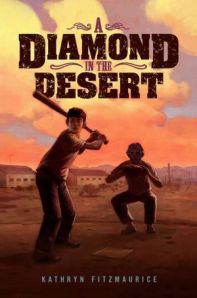 A quiet book, my friend said, and yet something makes you want to keep reading. She was speaking of the new middle grade novel, A Diamond In The Desert by Kathryn Fitzmaurice. Last night I discovered for myself just how compelling this book is. Yes, last night, because I began reading after 8:00 and devoured all 242 pages before I had my morning coffee. (OK, it is middle grade and there is a significant amount of white space, but for this slow reader, finishing so quickly is notable!)
A quiet book, my friend said, and yet something makes you want to keep reading. She was speaking of the new middle grade novel, A Diamond In The Desert by Kathryn Fitzmaurice. Last night I discovered for myself just how compelling this book is. Yes, last night, because I began reading after 8:00 and devoured all 242 pages before I had my morning coffee. (OK, it is middle grade and there is a significant amount of white space, but for this slow reader, finishing so quickly is notable!)
Yesterday I started using Donald Maass’s excellent Writing The Breakout Novel Workbook in my own work, and came upon the element I believe is the key to Kathryn’s writing: creating inner conflict. I’ve studied Maass’s Workbook before, but I don’t think I realized how true and powerful inner conflict can be until I read A Diamond In The Desert, with Donald Maass’s words fresh in mind.
He defines inner conflict as a character with
two goals, needs, wants, longings, yearnings, or desires that are in direct opposition to each other. Wanting two things that are mutually exclusive means having inner conflict, being torn in two directions, and that is what makes a character truly memorable. (p. 19)
In Kathryn’s book, the main character, a teenager held in a Japanese internment camp during World War II, comes to a point of crisis when he wants to play baseball, the only semblance of “normal” from his life before the camp and a great love, but at the same time must care for his little sister, who he also loves, while his mother is at work.
Two things the character wants — one a passion, the other a responsibility. And he takes his responsibilities seriously, especially because the family has been separated from their father. The struggle doesn’t last long. The character must make a choice. But the resulting consequences drive the action from that point on. The decision may be a done deal, but the character must learn to live with it.
As I thought about this inner struggle that made this quiet book a story I didn’t want to put down, I realized that Kathryn had also masterfully created inner conflict in her debut novel, The Year The Swallows Came Early. In that one, the protagonist loves her father and to her horror, he is arrested one day while they are walking together. Worse yet, she finds out the person who filed a complaint against him is her mother, who she also loves. Inner conflict.
In one part of Maass’s Creating Inner Conflict Exercise, he says
True inner conflict involves wanting two things that are mutually exclusive. It is most effective when it tears your protagonist, or any character, in two opposite directions. (p. 24)
Can you love both your mother and your father when one seems to be hurting the other? Can you satisfy both your passion and your responsibility? These are struggles the characters in Kathryn’s books faced, struggles which made their story compelling. What would they decide? How would it affect them?
It’s the same struggle Frodo Baggins faced in The Fellowship Of The Ring. Would he shoulder the responsibility of destroying the ring or return to his home in the Shire? As this book neared its conclusion, the conflict shifted to his facing the responsibility alone in spite of his fear or turning aside and remaining with his companions. Two things at the beginning and at the end that can’t both happen — or apparently so.
In stories that end happily, it seems authors find a way for the two to both take place, or for one to turn out not as good as it first appeared, or for one to be proper and appropriate to give up as a way of maturing. In the latter, there may be sweet sadness, the sense of necessary loss, and the story still ends on a positive note.
Quiet books are built largely on these kinds of inner conflicts. But what about adventures, thrillers, science fiction, even romance? Certainly those stories have external conflict that drives the story, but an author who also incorporates inner conflict — as J. R. R. Tolkien did — has a memorable character to go along with action-induced edge-of-the-seat tension.


![PowerElementsCharacterDevelopment[1000][1]](https://rebeccaluellamiller.files.wordpress.com/2015/05/powerelementscharacterdevelopment10001.jpg?w=205)





